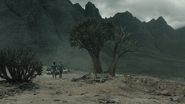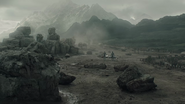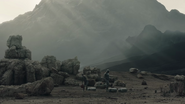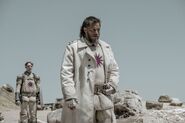| “ | I've learned now that this world isn't like Mother and Father. It doesn't care if we're happy, and it doesn't get sad when we die. | ” |
| — Campion about the harsh nature of Kepler-22b[src] | ||
Kepler-22b is an extrasolar planet orbiting within the habitable zone of the Sun-like star Kepler-22. It is located about 587 light-years from Earth in the constellation of Cygnus. Kepler-22b's size is roughly twice that of Earth. In the real world, it was discovered by NASA's Kepler Space Telescope in December 2011 and was the first known transiting planet to orbit within the habitable zone of a Sun-like star, where liquid water could exist on the planet's surface.[1] In Raised by Wolves, during the 22nd century[2], Kepler-22b is a semi-habitable, though not hospitable, planet. Soil is fertile and crops can be grown, though the weather conditions are harsh and drastic, bordering on unlivable, and the presence of radioactive pits[3] pose great health risks to humans.
The humans of Earth decided to colonize Kepler-22b to preserve their species in the 22nd century after the Religious War destroyed Earth's ecosystem. A small colony ship prepared by the atheist Campion Sturges arrived on Kepler-22b in 2145 and established a small settlement of humans grown from embryos and raised by android caretakers; only one of six children, Campion, survived. The slower Mithraic Ark of Heaven, which held 1,000 living humans, left Earth in 2145 and arrived in Kepler-22b's orbit in 2157; the Ark was destroyed by the atheist Necromancer android Mother, killing almost all of the Mithraic colonists. As the atheist colony clashed with the Mithraic survivors, both sides began to discover that Kepler-22b was not devoid of other intelligent life as they previously believed.
Characteristics[]
Kepler-22b is an extrasolar planet orbiting around the star Kepler-22. It is about 587 light-years (180 pc) from Earth in the constellation of Cygnus. Kepler-22b's radius is roughly 2.4 times that of Earth.[1]
Its mass and surface composition appears to be primarily sand and rock with some trees and vegetation. The local plantlife is very Earth-like, with tuberous, succulent desert plants called as "carbos", and deciduous tree-like plants in the mountains. There are large pits in the ground, the origin of which are unknown, that contain radioactive material and are alarmingly deep. The pits appear to also serve as tunnels in some areas. The land is also covered with serpent-like skeletons of an unknown origin and nature.
The planet is partially hollow: the large, radioactive pits scattered across the surface penetrate all the way to the planet's core, which is a massive cavern containing an enormous, gravitationally suspended sphere of what appears to be magma. Although the heat close to the core is extreme, it is possible to travel from one side of the planet to the other via these pits using a lander.
Habitability[]
Kepler-22b has a variety of biomes. The mountainous region where the Settlement was established had a taiga-like that fluctuated between below-freezing temperatures with frequent snow flurries at night, to relatively hot and arid during the day. Soil is fertile and crops can be grown, but the weather conditions are harsh. This region also bordered a large desert.
The planet also has a "tropical zone" about 3,000 miles away from that is significantly milder and easier for humans to live in. The tropical zone features an extensive jungle with abundant edible plants and even native fauna, but also has downsides. It lies adjacent to vast acidic seas that rapidly dissolve both inorganic and organic objects other than stone. The zone is also shrouded in a natural electromagnetic field that interferes with electromagnetic transmissions. This makes piloting air and spacecraft difficult, and also blocks the Signal.
The presence of radioactive pits[3] across Kepler-22b's surface pose great health risks to humans. There is also an an unidentified species of feral creature that are hostile to humans, but these can be hunted and eaten by humans.
Previous civilization[]
Kepler-22b appears to have been inhabited at some point, as a large stone dodecahedron was discovered by the Mithraics in one of the planet's desert regions. A humanoid entity who was dressed in rags was also encountered by the Mithraics; this entity was intelligent enough to make a crude map of the region surrounding the desert and the Atheist colony, and possessed metal cards that were engraved with symbols and encoded with data that could be read by an android. There were also the remains of an ancient android that was the focus of an unknown ritual held by other humanoids.
Based on the appearance of a humanoid that Mother killed and a chemical analysis of a human neanderthal skull in its possession, Father concluded that humans had previously inhabited Kepler-22b long ago. For unknown reasons these humans had devolved into more primitive forms, including the humanoids and the more numerous feral creatures. It is unclear if the Kepler-22b humans originated on Earth and traveled to Kepler-22b in ancient times, originated on Kepler-22b and colonized Earth, or even originated elsewhere.
People[]
Residents[] |
Visitors[] |
Trivia[]
- The series was filmed in South Africa, substituting for the exoplanet Kepler-22b.[4]
Multimedia[]
Images[]
Videos[]
References[]
- ↑ 1.0 1.1 This page uses Creative Commons Licensed content from Wikipedia (view authors).
- ↑ Pentagram. Raised by Wolves. Season 1. Episode 2. HBO Max.
- ↑ 3.0 3.1 Virtual Faith. Raised by Wolves. Season 1. Episode 3. HBO Max.
- ↑ 'Raised By Wolves' brings Ridley Scott's new sci-fi vision to HBO Max (review) - Space







